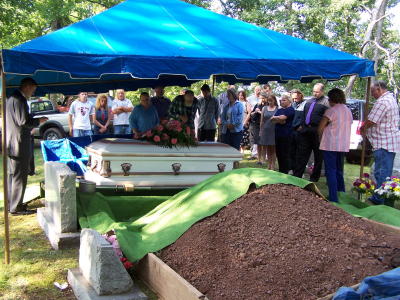
By Bob Weaver 2006
They seldom return to be buried on the Husk.
But every now and then, an old soul comes back to rest near their origins.
Opal was returned to her resting place yesterday, a spot we've described as a backwoods altar, the remote ridge between the faded villages of Hur and Richardson.
The 91-year-old Opal Carpenter Coon Miller had lived in Ohio with her daughter for many years, after leaving Calhoun and Roane, following the death of her first husband.
Over the years, when I talked with her, she always wanted to come home to Hur and the ridge.
Opal was a woman of the woods, not unlike her mother Rosabelle Carpenter, who lived in a tiny plank house on the Husk most of her life, one of the last women to leave the remote area. She was known for her diet of chicken eggs.
Once there were about 35 families living on the ridge or in nearby hollows. Today the ridge is empty of human habitation.
Rosabelle was born in a log cabin belonging to her parents Alfred and Margaret Carpenter, in a deep and narrow hollow off the ridge, a spot that rarely saw sunshine.
It was her daughter, Opal's sister, Bethel Ann that froze to death on the Husk in 1947 with her husband Amos.
READ "Frozen On The Husk, No Matches To Be Found"
During the 1960s, Opal and her husband Ezra lived in a hard-to-reach hollow off Steele Hollow near Spencer. Not having a phone, she purchased a CB radio to have contact with the outside world. Having a CB at the funeral home where I worked in Spencer, we would chat about every day.
When Opal's mother died about 50 years ago, as a funeral director, I brought her back to the Husk for burial, trudging through mud "knee deep to an elephant." As a well-dressed mortician, I was covered head to toe with red clay mud.
It was on this ridge you could find "Snuff Box Glory," known by most as Tuttle Hill, where teachers and students rubbed snuff all day long, all having convenient spittoons next to their desks. It doubled as a house of worship.
Nearby is Paulcer's Knob, where Paulcer McCune hid after going AWOL during the Civil War.
At one end of the ridge was the famous election day "Buckhorn Riot" which broke-out in 1928.
While hunting you can still climb over rock fences, built to protect crops and keep in pasture animals, no money for barbed wire. During tough times, some of the Husk's ate weed soup and snow birds to get through the winter, after the crops failed.
Yesterday, it seemed rewarding to be at the Carpenter Cemetery, close to the place from whence they sprung, simply recalling the lives of these tough survivors.
| 


